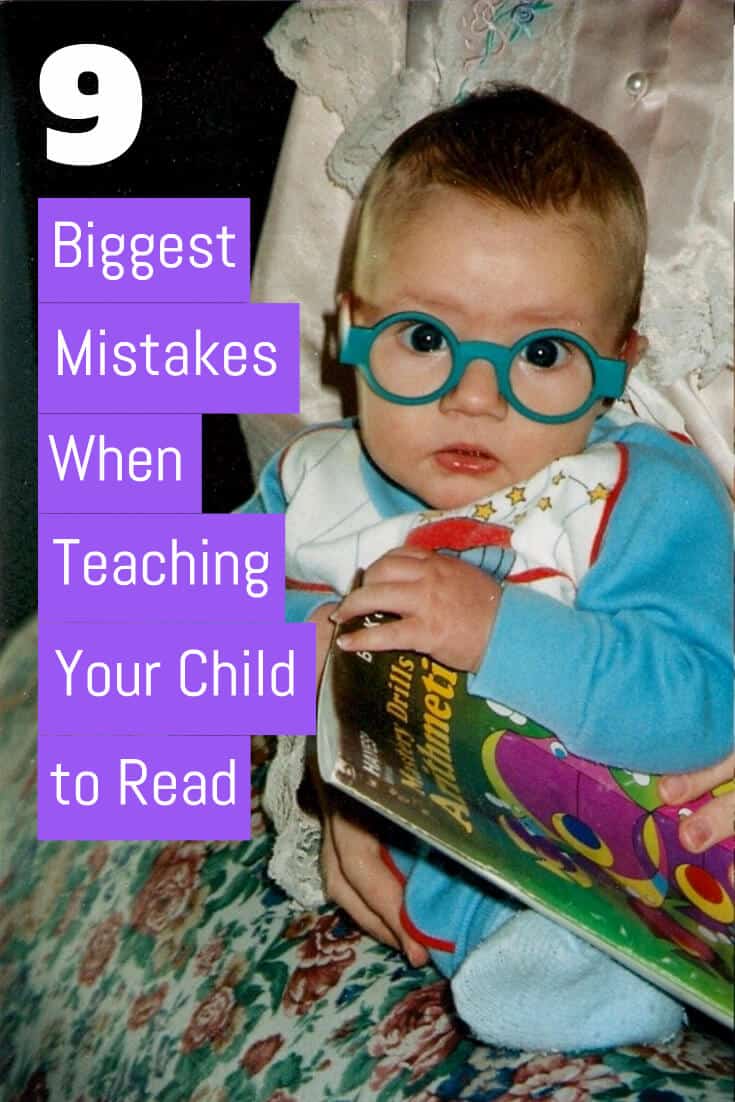9 Biggest Mistakes When Teaching Your Child to Read

Most homeschool parents are familiar with some common methods used to teach reading to their child. What you may not know is that there are also some big mistakes that you can make that will hinder your child’s progress and frustrate them making learning to read stressful and difficult. Here are some of the biggest mistakes that you can make when teaching your child to read.
Mistake #1 Teaching Reading Too Early
Each child is different and learning to read should be a peaceful and enjoyable time for you and your child. If reading is not enjoyable for them, they will want to stop delaying their progress even more.
You will know when they are ready to learn to read by subtle cues such as an interest in books and words that they see in life. Don’t compare your child to others. Simply let them be who they are and learn at a pace that is comfortable for them.
Mistake #2 Too Much at Once
When you do begin to teach reading, take it slow. Don’t try to accomplish too much in one sitting. Take your time and only cover a few minutes each day, to begin with.
Don’t try to complete an entire lesson plan if your child is becoming frustrated. Break it up and teach it over several days if need be. The more positive the experience is the more receptive your child will be to it.
Mistake #3 Complicating the Process
There are four basic concepts to be taught in regards to each letter of the alphabet: the name of the letter, the symbol of the letter, the sound of the letter and how letter sounds start words. Children need to learn only one of these concepts at a time for all of the letters. Keep it simple and teach that “A says the short A sound” first.
Mistake #4 Teaching Letter Symbols Before Sounds
Because the process of reading is done using sounds, it is best to teach the sounds of each letter before you teach the names of each letter. When you show a child an F they should learn to say “Fffff” first. Only after ALL of the sounds have been learned should the names of the symbols be taught.

Mistake #5 Associating Letters with Pictures
Many alphabet flashcard sets have a letter on one side and a picture on the other. Be careful that your child does not learn to associate a letter with a picture instead of a symbol. If they begin to think “alligator means A” it will add an unnecessary step to the process and slow their learning. The process should only be: see the symbol>think of the sound.
Mistake #6 Teaching with Uppercase Letters First
95% of the written word uses lowercase letters. Teaching uppercase letters first puts your child at a disadvantage as they will only use the uppercase occasionally. Teach kids to associate a lowercase symbol with a sound and then the uppercase symbol with a sound.
Mistake #7 Teaching the Lesser-Used Sounds Of Letters First
Teaching the most-used sounds of letters first will help your child learn to read easier, faster. Teaching the long vowel sounds, such as: "i" is for "ice cream" or "a" is for "acorn" is not the most common sound of those letters. Short vowel sounds and hard “c” and “g” sounds are used more commonly and should be taught first.
Mistake #8 Using Difficult Books to Teach Reading
Many first reader books have only one word on each page. These types of books are perfect for beginning readers. Books with text that is difficult to predict or books with complicated words in them are not good to use to teach early reading skills.
Mistake #9 Stopping Reading to Your Child
Just because a child is learning to read for themselves does not mean that they no longer need you to read books to them. The opposite is actually true.
Reading aloud to your beginning reader is a great way to encourage them. Showing them that reading can be fun and that there are so many more adventures yet to be discovered in books will motivate them to continue to learn.
Don’t make these mistakes with your child. Get off to a great start and hopefully, your child will quickly gain a love of reading that lasts a lifetime.







Good point on 95% of letters being lower-case! All of my practice sheets used upper and lower equally, and usually together. I'd never thought about the % carry over.
Then again, they'll probably have a lot more practice (naturally) with the lower-case.
Also, your baby is SO adorable!!!!